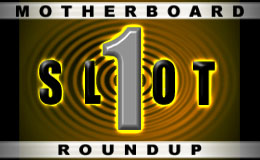Hardware
Audio
Controllers
General
Mainboards
Memory
Modems
Monitors
Portables
Printers
Processors
Scanners
Storage
Video
Games
Reviews
Previews
Cheats
& Hints
News
General Info
Slot 1 Motherboard Roundup By
Chamila
Sumanasekera
July 28, 1999 (Updated) Introduction |
 |
We’ve
said this before (and we’ll say it again), but the motherboard is not only
one of the most important components of any system but also one of the
components least often recognized as such. When was
the
last time someone came up to you and bragged about their really cool motherboard,
as opposed to, to pick an entirely random example, their new processor
or their new graphics card or sound card? You could think of this as a
case of missing the wood for the trees, since your motherboard is literally
the most fundamental part of your computer in that everything else connects
to it, directly or indirectly. That also means, however, that it is your
motherboard that determines what exactly you can chuck into your computer.
Nowadays, nobody builds a system without allowing for future upgradability
as best as possible- and nothing will matter so much in deciding the limits
of your future upgradability as your choice of motherboard.
OK,
a quick note about some of the various new types of motherboards around
these days. Until quite recently, we lived in the uncomplicated world of
Socket 7 motherboards. Then with the release of the last round of new processors,
we saw a corresponding new wave of different types of motherboards. Among
them were the Super 7 standard, which you need for AMD’s current top-of-the-line
processor, the K6-III
(it
can also handle AMD’s old K6 & K6-2 processors and the rather musty
Intel Pentium processors, but mentioning that seems kinda redundant when
you’re talking about upgrades) and which was basically the Socket 7 design
with specific improvements like 100MHz FSB and AGP. Once AMD releases the
K7 processor (expected next month -at the moment), that will require a
new design to be called Slot A, which will be physically identical to but
electrically incompatible with the Slot 1 design. But we’re anticipating
ourselves here- the Slot 1 design is the most popular choice at the moment
because it allows you a much wider choice than any of the types mentioned
above- you can run anything from SEPP Celerons to Pentium IIs & Pentium
IIIs on a Slot 1 board. Certainly a much wider choice than the other choice
of motherboard, the Socket 370 boards, designed solely for Intel’s PPGA
(Plastic Pin Grid Array) Celerons.
Evidently,
taking a look at some Slot 1 motherboards is the best way to start your
search for a new motherboard. With that in mind, we’ve put together a positive
whopper of a motherboard comparison for you- sixteen Slot 1 motherboards
are reviewed and compared in the following pages. But first, however, there
are some things we simply have to mention before we get to the boards themselves,
so lets line ‘em up and knock ‘em down in short order.
|
|